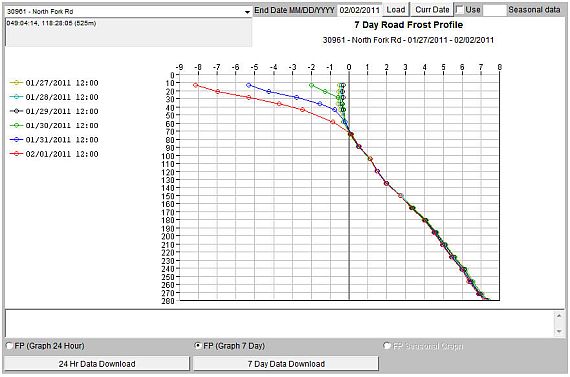|
During spring runoff, heavy vehicles travelling on B.C. Highways can cause serious damage to some roadways, due to excess water under the road bed.
To protect the roadway, the B.C. Ministry of Transportation and Infrstructure has in place a Seasonal Strength Loss Program. This program indentifies and imposes load restrictions on roads, or portions of roads that have been weakened by excess water in the road base. Once excess water has been removed from the road base, and the road has been determined to be structurally sound, load restrictions can be lifted.
Why are load restrictions needed?
In the spring, thawing of a road begins from the surface and moves downward - above the frozen layer. As the thaw progresses, the water may not efficiently drain out of the soil, as the surrounding soil can remain frozen and impermeable. As the thawing continues, the soil then becomes temporarily saturated with water, which reduces the pavement structures effective strength (bearing capacity) to carry vehicular traffic. If surplus water is present in the granular base material of a paved road, the majority of damage will occur in the asphalt layer. If the frost has extended down deep into the base layers of a road, damage may occur in the entire road structure as the fines may be "pumped" up to higher structural layers of the road by heavy truck traffic.
What is the Seasonal Strength Loss Program?
To protect the roadway, the ministry has in place the Seasonal Strength Loss Program. This program indentifies and imposes load restrictions on roads, or portions of roads that have been weakened by excess water in the road base. Once excess water has been removed from the road base, and the road has been determined to be structurally sound, load restrictions can be lifted.
Where and when are load restrictions applied?
The ministry is aware of the impact of imposing restrictions upon our roads. That's why restrictions are applied only where and when they are needed, not on a blanket basis. If you are noticing any discrepancies between different areas, or different parts of the districts, it is because roads will experience thawing at different rates based on site characteristics such as temperature, exposure, soil and road construction materials, moisture levels in the roadway, topography, drainage and local weather patterns.
How are B.C. highways monitored for strength loss?
BC Ministry of Transportation and infrastructure, with assistance from our highway maintenance contractors, continuously monitor our roads for changing conditions. In addition to this, we utilize other tools such as our frost probe sites, weather forecasts, control section data beaming and anecdotal history. The picture below illustrates where the frost is in the ground at one of our sites on the North Fork Road in the Grand Forks area. The horizontal axis is temperature (Celsius) and the vertical axis is depth below road surface (cm).

|